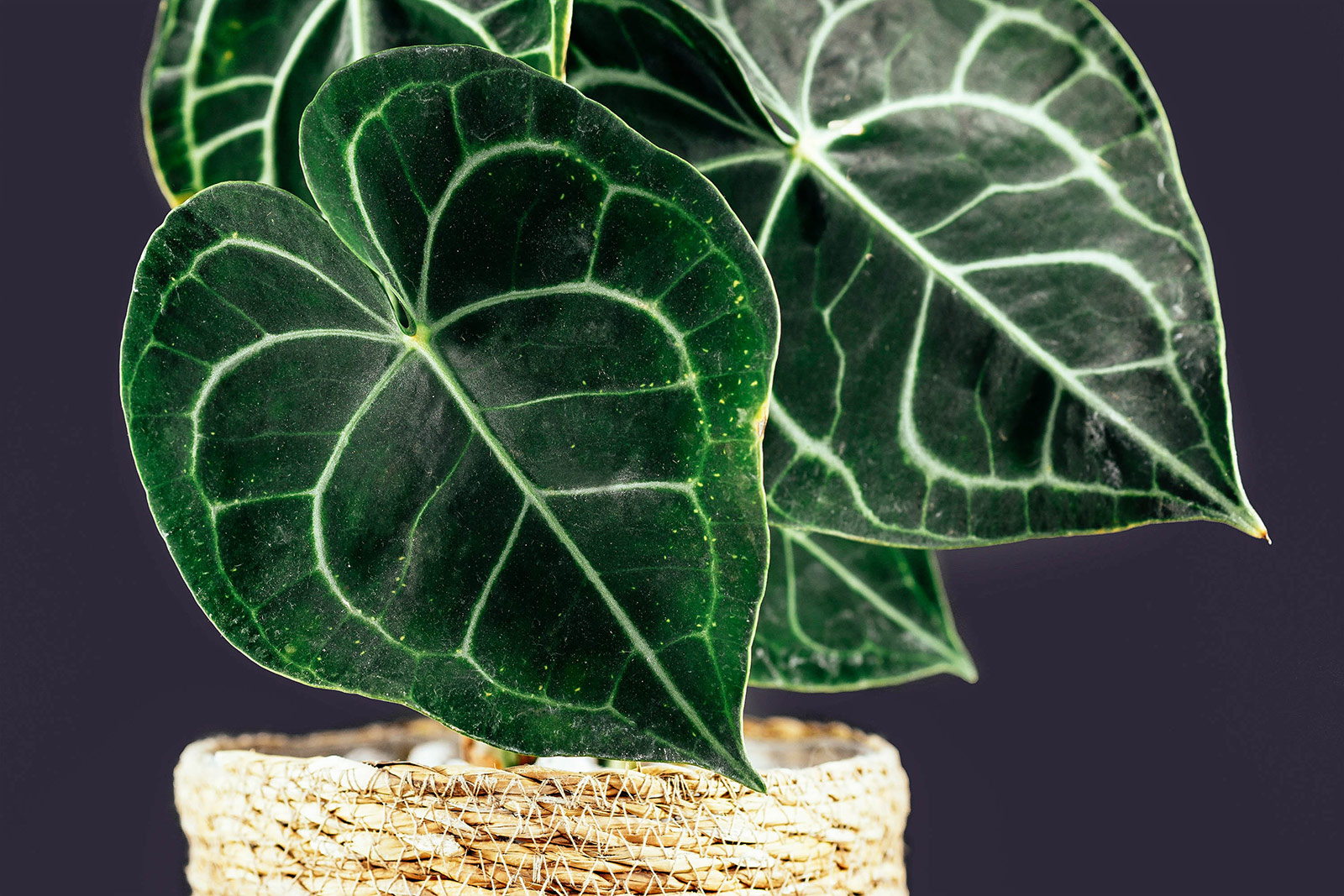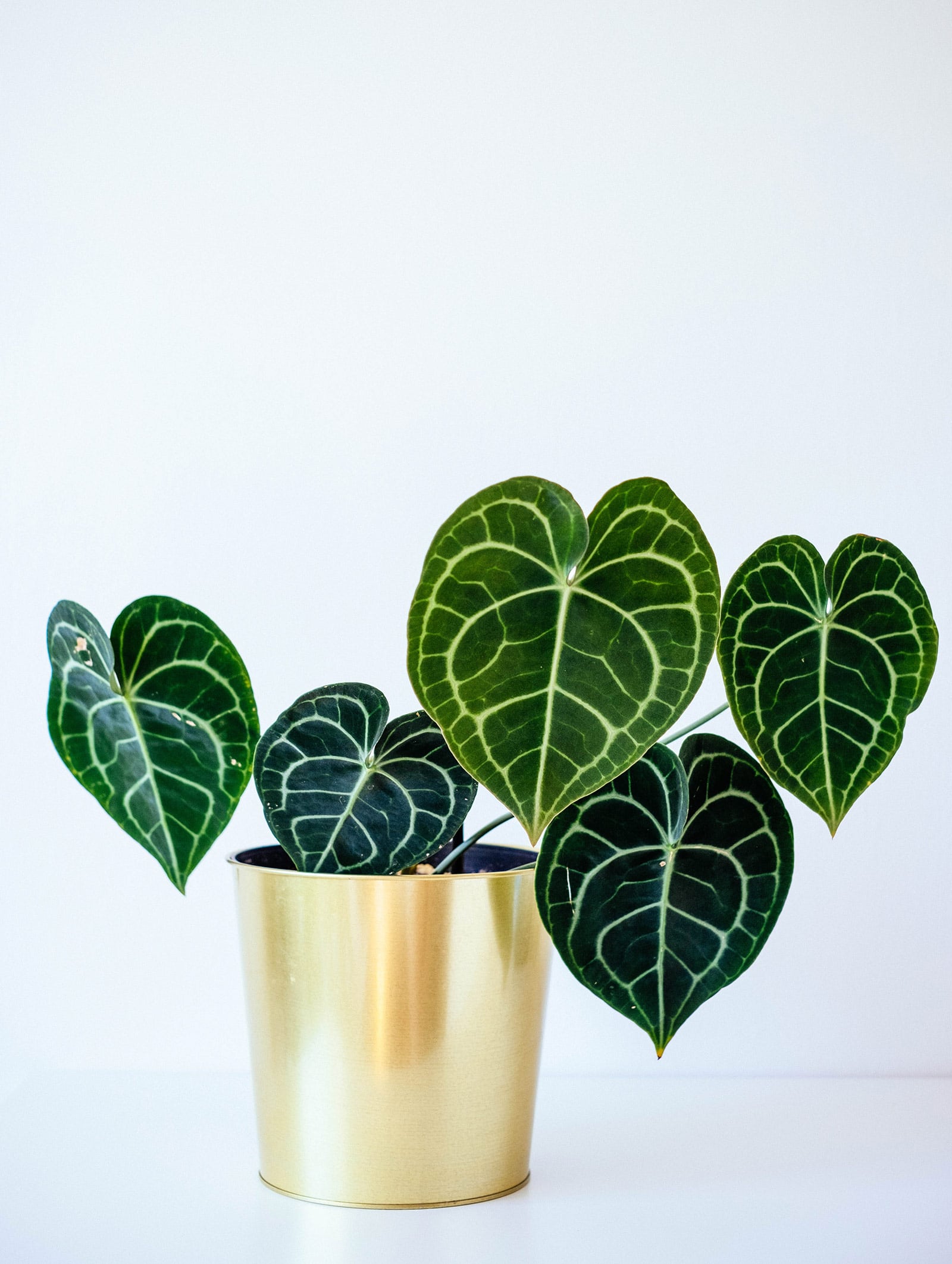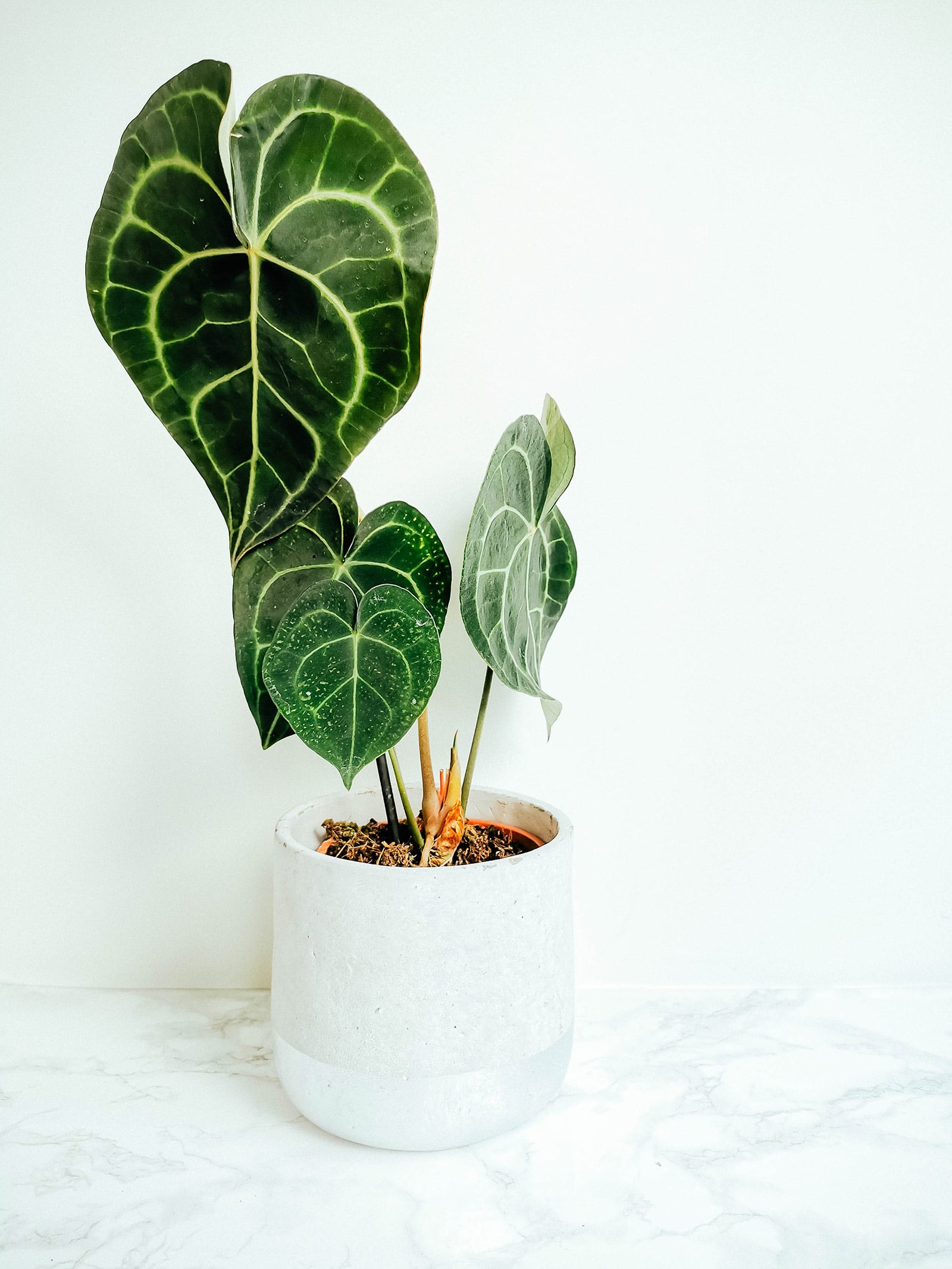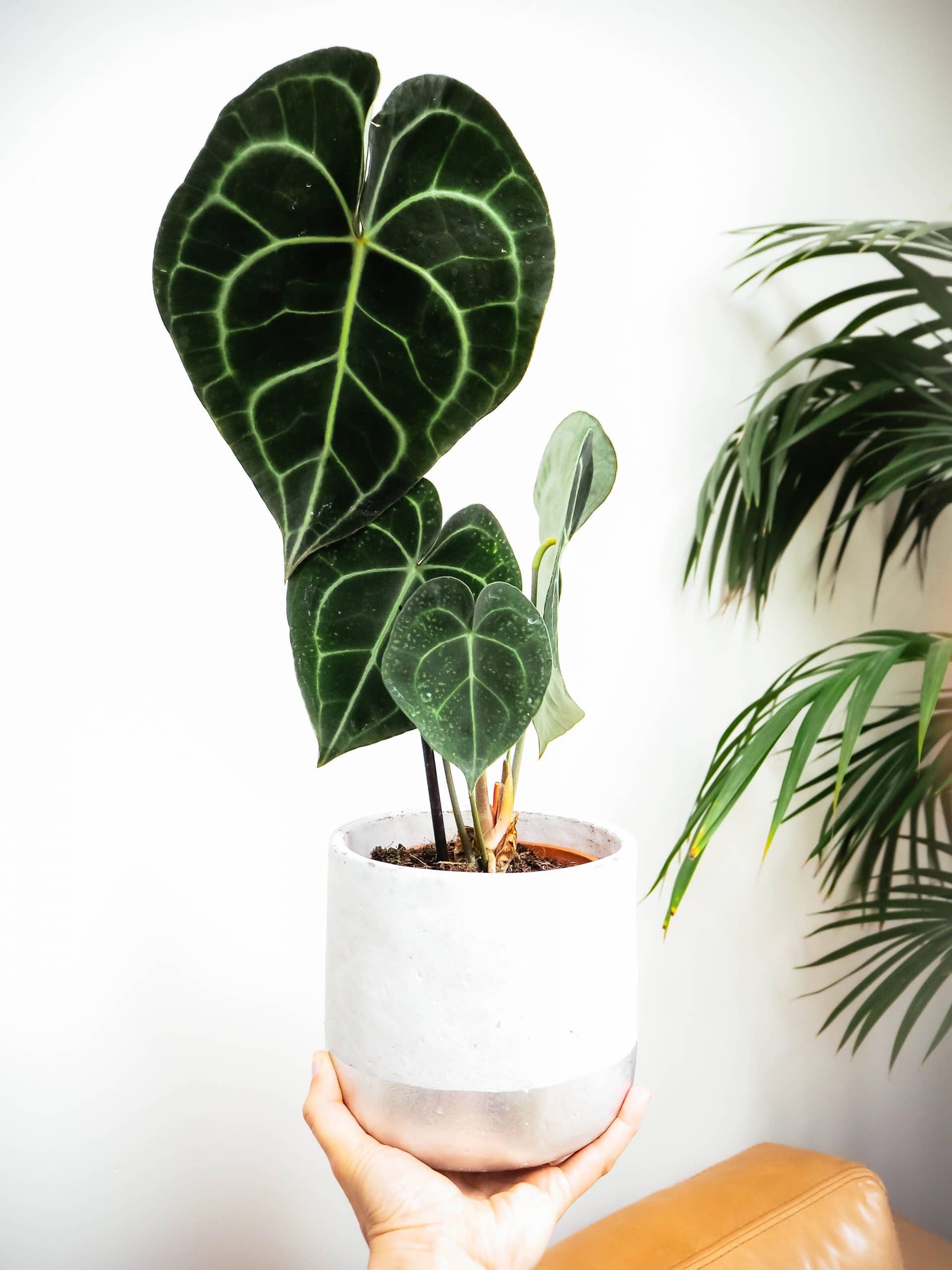Have I got a plant for you today! A species that has taken the houseplant world by storm over the course of just a few years, and one that—although it’s a little easier to find now—is still relatively rare, highly coveted and often on the expensive side. I’m talking about Anthurium clarinervium, which unlike its cousin the flamingo flower, is grown for its spectacular foliage rather than its blooms.
Keep reading for everything you need to know about Anthurium clarinervium care and growing this beautiful aroid houseplant indoors.
| Common name(s) | Velvet leaf Anthurium, velvet cardboard Anthurium, esqueleto |
| Scientific name | Anthurium clarinervium, Anthurium clarinervium Matuda |
| Family | Araceae |
| Height and spread | Up to 30 inches high and wide |
| Light | Bright indirect light |
| Soil type | Aroid soil |
| Water | Keep lightly moist |
Disclosure: If you shop from my article or make a purchase through one of my links, I may receive commissions on some of the products I recommend.

About Anthurium clarinervium
Natural habitat
Anthurium clarinervium, also known as the velvet leaf Anthurium or velvet cardboard Anthurium, is a true tropical. It’s endemic to Mexico, although some sources also note its occurrence in Panama. Specifically, it’s naturally found in the northern part of Chiapas, which is one of the country’s southern states and borders Guatemala.
Here, it sometimes occurs terrestrially but usually as a lithophyte: a plant that naturally grows on rock rather than in the soil. (Tillandsia is another lithophyte you may be familiar with.)
The species is usually found on karst, which is a type of topography characterized by rocks like limestone and typical for the Mexican Chiapas region. Due to the types of rocks comprising this type of habitat, the soil often features a higher pH level. The region is filled with tropical wet forests (better known to most of us as rainforests): hot, rainy, and moist.
All of the above tells us a good bit about how this species would like to be treated in the home!
Description
Anthurium clarinervium is an aroid, meaning it belongs to the overarching plant family of Araceae. This family contains some of the more spectacular houseplants out there (like Alocasia ‘Polly’, Philodendron ‘Pink Princess’, and Monstera ‘Albo Borsigiana’) and this one is no exception! It’s beloved for its perfectly heart-shaped leaves, which are a deep, dark green and have a velvety feel to them.
The leaf veins are much lighter green in color, making for a very dramatic effect. That’s why Anthurium clarinervium and its similar cousins (like Anthurium crystallinum) are often called “esqueleto” in Spanish. The name means “skeleton” and is obviously a reference to the fact that the leaf veins are reminiscent of a skeleton’s ribcage.
The flowers look like those of a typical aroid: white spathe, cream spadix. They’re pretty insignificant as far as flowers go, though most aroids (including more popular specimens such as Philodendron gloriosum) are primarily grown for their foliage. When pollinated, the flowers can produce small, orange, berry-like fruits that contain the seeds.
The velvet cardboard Anthurium doesn’t grow to be a huge plant if you keep it potted (things may be different in a more natural environment, like if it’s planted in full soil in a greenhouse). I wouldn’t expect more than a 30-inch height and spread from this one. The leaves aren’t quite as big as with some other Anthuriums either, with a maximum height of around 10 inches and width of 6 1/2 inches.

Anthurium clarinervium varieties
This Anthurium has been very widely hybridized; in fact, it actually sometimes naturally does so with closely related species in the wild. Many of the Anthurium clarinervium specimens you’ll find for sale are actually apparently not “pure,” although it’s usually impossible to tell what other Anthuriums are mixed in there.
If you want a true clarinervium, don’t forget to look at photos of the species in the wild and compare those to the plant you’re looking to buy to make sure they match.
Some of the Anthurium clarinervium varieties and crosses that I’ve heard of are the following. They’re not common by any means and you’d probably have to browse specialized aroid houseplant sites and enthusiasts’ collections to find them.
- Anthurium clarinervium ‘Dark Form’: Characterized by its darker leaves and clearer leaf veins, making for an even more dramatic display than the original version.
- Anthurium faustomirandae x clarinervium: Large, green, heart-shaped leaves with slightly lighter veining.
- Anthurium clarinervium x ‘Pterodactyl’: More elongated foliage than pure clarinervium.
- Anthurium clarinervium x pedatoradiatum, also referred to as Anthurium ‘Macrolobium’: Very dramatic, large leaves. They remind me of dragon wings!
Where to buy Anthurium clarinervium plants:

Caring for Anthurium clarinervium
Light and temperature
Like most houseplants that naturally grow on the jungle floor, Anthurium clarinervium prefers bright but indirect light. It doesn’t like to be in the dark by any means, but it also doesn’t appreciate harsh sun, especially without proper acclimation. Keep it on a windowsill, but not one that gets blasted with afternoon rays. Artificial lighting is fine as well
Temperature-wise, you’re also looking to imitate rainforest conditions. Chiapas, the province in Mexico where this plant is naturally found, is one of the warmest regions of the country. Even average nighttime temperature never falls under 68°F in most of the area. This means your velvet cardboard Anthurium won’t like the cold!
High temps, on the other hand, are no problem for it (average daytime temps in Chiapas are above 86°F nearly year-round).
Room temperature should be fine for your plant, so if you’re comfortable in your home, your Anthurium clarinervium should be as well. I’d recommend avoiding letting things drop below 60°F just to be on the safe side.
Water and humidity
The word rainforest says it all: lots of rain. However, keep in mind that Anthurium clarinervium doesn’t naturally grow in the soil, so it’s not used to sitting in a waterlogged medium. Keeping it too wet is a surefire way to promote root rot, which is one of the main causes of dying plants in general. This especially applies in winter, when plants don’t tend to be actively growing or there’s not enough light.
Instead, be sure to flood your plant frequently, but let the excess water drain. You’re aiming for lightly moist here. I can’t tell you exactly how often and how much to water your velvet cardboard Anthurium as this will depend entirely on factors like the season, light, soil type and more, but a good rule of thumb is to give the plant a drink once the first 2 inches or so of the medium have dried. If you’re not sure, stick a finger in the soil to gauge its moisture level.
As for humidity, that should be kept high at all times. The average home in most areas doesn’t supply enough air moisture for jungle aroids like this one, especially during winter. That’s why it’s usually a good idea to run a humidifier. An inexpensive humidity meter like this one will help you tell where you’re at; you’ll want to see 50 percent humidity or higher on there at all times, with 70 percent being ideal.
Soil and planting
With this Anthurium species being a lithophyte by nature, it’s important to keep in mind that its roots haven’t evolved to be contained in dense soil. They need plenty of oxygen to thrive. As such, your soil mixture should be loose and airy, allowing excess water to drain freely.
That being said, it should also have some water-retaining elements to prevent it from drying out completely right away. It’s all about balance!
Every houseplant enthusiast has their own preferred soil mixture, as the specifics usually depend on your own watering habits. What the mixes all have in common is that they combine ingredients that retain water (potting soil, peat, sphagnum moss, coco coir) with ingredients that improve aeration (perlite, orchid bark, charcoal, crushed lava rock).
Examples of mixtures that would work for Anthurium clarinervium include:
- 50 percent houseplant potting soil, 25 percent perlite, 25 percent orchid bark
- 50 percent houseplant potting soil, 20 percent orchid bark, 20 percent sphagnum moss, 10 percent perlite
- 33 percent sphagnum moss, 33 percent perlite, 33 percent orchid bark
As for planting, it’s best to avoid unglazed terracotta containers unless you tend to overwater. Due to their porous nature, these let the water evaporate a little too quickly for a plant of this nature. Make sure any pot you use has a drainage hole in the bottom.
Recommended products for Anthurium clarinervium care:
- Soil Sunrise Philodendron Houseplant Potting Soil
- Good Earth Organics Premium Potting Soil
- Burpee Organic Coconut Coir
- Better-Gro Orchid Moss
- Better-Gro Orchid Bark
- Perfect Plants Organic Perlite
Fertilizing
This isn’t a heavy feeder, but like almost all houseplants, it will still appreciate some fertilizer from time to time during the growing season. You can apply a normal, balanced houseplant fertilizer while watering.
As always, don’t use plant food during the winter months or if your Anthurium clarinervium isn’t actively growing or doing well. It won’t be able to use the nutrients and the fertilizer will just end up burning the roots. If this happens, be sure to flush the soil with plenty of distilled water.
Recommended fertilizers for Anthurium clarinervium:
- Houseplant Resource Center Liquid Fertilizer for Houseplants
- Instant Biologics Instant Plant Food (Fizzing Nutrient Tablets)
- Maxsea All-Purpose Seaweed Plant Food
Pruning
This isn’t a plant that you’ll need to prune, except maybe to remove dead or sickly foliage.
Dividing or repotting
Repotting houseplants like these is best done every one to two years, preferably during springtime. Even if they don’t need more space yet, it’s usually at least a good idea to provide fresh soil, as some soil mix ingredients do break down over time.
If you’ve taken good care of your Anthurium clarinervium and have a multi-stemmed plant on your hands that’s now in need of a repot, you have a decision to make: Should you go for a bigger planter or divide it up so you’ll have two? After all, that way you can keep the original in the same container.
Well, it’s all up to you, and dividing is actually the easiest way to propagate a velvet cardboard Anthurium.
If you’d like an extra plant to keep, give away or sell, division is the way to go. But I have to say… I personally like mine as big as possible in a single container! It’s just such a dramatic display with those striking leaves.

Propagating Anthurium clarinervium
As mentioned above, if you’d like to multiply your Anthurium clarinervium, the easiest way to go about it is to wait until it’s mature enough to have multiple stems. Then, divide while repotting. It means minimal trauma for the plant and the new specimen should already have its own root system. That way, it’s more likely to survive and thrive.
It is possible to take stem cuttings, however. More mature plants will have a clearly visible stem and you can behead a mother plant in order to re-root the top. The leftover, bare stem on the original will resprout.
You can also grow Anthurium clarinervium from seed. It’s something the more dedicated aroid enthusiasts do all the time, often attempting all sorts of crosses between species in the process. You’ll just have to pollinate any flowers and then be very, very patient while the berries ripen to an orange color.

Common questions about Anthurium clarinervium care
How do I tell the difference between Anthurium clarinervium vs. crystallinum?
Yep, I’m not surprised these tend to be confused! They are very similar, but there are some differences. Most obviously, crystallinum leaves are more elongated and tend to be lighter in color. Anthurium magnificum can also be similar as a juvenile, but you can tell that one apart by the humongous leaves on adult plants.
Is Anthurium clarinervium fast growing?
Most species of Anthurium, including clarinervium, are slow to moderate growers. Under ideal conditions, velvet cardboard Anthurium plants will need new larger pots every year (going up an inch or two in pot size each time).
Why is my Anthurium clarinervium yellowing?
If your Anthurium clarinervium is showing yellowing leaves, that’s a sign the plant is stressed. Typically this means it’s being overwatered or underwatered, so the first thing to adjust would be your watering habits, followed by checking the potting medium.
If the soil mixture has become too dense, repot the plant in fresh soil with a little bit of perlite added in for aeration.
Is Anthurium clarinervium toxic to cats and dogs?
Like other aroids, all parts of Anthurium clarinervium contain insoluble calcium oxalate crystals. This compound irritates the mouth and throat upon contact, so if your pet takes a bite, be sure to offer plenty of water. That being said, serious trouble is very unlikely.
Sources:
https://powo.science.kew.org/taxon/urn:lsid:ipni.org:names:15185-2
https://www.exoticaesoterica.com/magazine/the-ultimate-guide-to-velvet-leaf-anthuriums
Croat, T. B. (1983). The origin of Anthurium leuconeurum. Aroideana, 6(4), l32-l34.
















complete and useful article, thanks for the information.